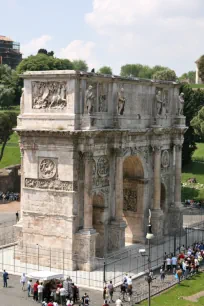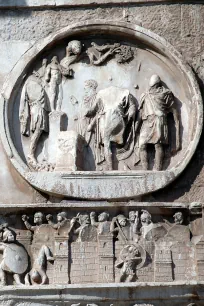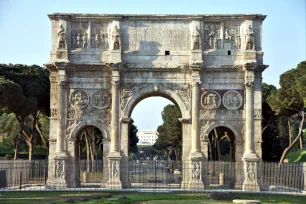Right next to the Colosseum stands the Arch of Constantine, erected in the early fourth century to celebrate the victory of Constantine over Emperor Maxentius. The arch, decorated with statues and reliefs, has survived the times relatively unscathed.

The Arch of Constantine is the most recent of the three remaining imperial triumphal arches in Rome. The other ones, the Arch of Titus and the Arch of Septimius Severus, are located in the nearby Roman Forum.
Constantine’s Victory
After years of civil war, the victory of Constantine’s army over the numerically superior army of Maxentius at the Battle of Milvian Bridge in 312 AD finally brought some peace to the Roman Empire. To commemorate this memorable victory, the Senate of Rome awarded Constantine a triumphal arch. It was dedicated just a few years later, in 315 AD.


The Arch

The large arch with three archways is almost 26 meters (85 ft.) wide and 21 meters (69 ft.) high. During construction, many parts from older structures were reused, which was common practice at the time.
The statues at the top were taken from the Forum of Trajan. They depict Dacian captured soldiers, defeated by the Trajan army. The relief panels between the statues were created for Marcus Aurelius, while the roundels (and possibly even the arch itself) are from Emperor Hadrian’s time. Some figures in the roundels were modified to resemble Constantine.
The decorations on the central and lower part were created specifically for this triumphal arch. The frieze shows the army of Constantine driving the troops of Maxentius into the Tiber. These decorations are visibly of a much lower quality than those from the era of Hadrian and Trajan, showing that the artistic level during the time of Constantine was substantially lower than in the past, symbolic for the decline of the Roman Empire.
Emperor Constantine
Constantine believed that his improbable victory over Maxentius was the result of the help of the Christian god. As a result, during Constantine’s reign, persecution of Christians ended and Christianity became the official religion in the Roman Empire. He also moved the capital of the empire from Rome to Constantinople in 325 AD (before known as Byzantium, now Istanbul).
- Next: Piazza del Popolo
- More Rome Ancient Sights
- More Sights & Attractions in Rome

